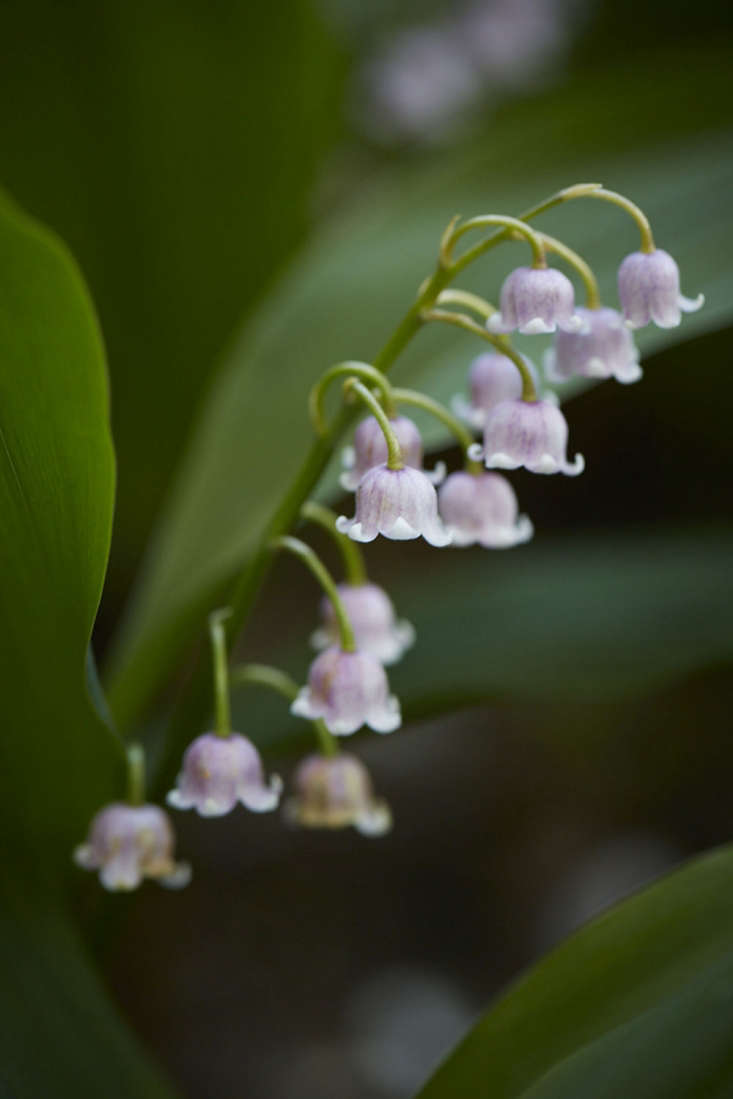The thing about lily of the valley is, you need to treat it like a cash crop, earning its space in your market garden. Unless it is cut and placed in water, the flowers are too small and dainty to appreciate, their exquisite scent wafting around your feet. Besides, it grows most happily as a monoculture and is not keen on company.
Photography by Britt Willoughby Dyer for Gardenista.

I treasure my colony of Convallaria majalis by the front door. The soil is damp and the aspect is darkly north-facing. They are sheltered under a shaggy climbing hydrangea and benefit from water dripping from the eaves of the porch. They’d look good, I used to think, with other spring flowers, like cowslips and snowdrops. In summer I could add more pale charm to the gloom, with Astrantia major, followed by Japanese anemone.

But I soon discovered that snowdrops, scattered around in a natural way, begin their slow and painful dying back just as lily of the valley sends up its small flower tips, cloaked by ample leaves. So I moved the snowdrops and waited for the cowslips to get going, but they didn’t. The anemones have fled to the back of the bed and the astrantia became a big, dry knot, ruining the effect of the spring colony, so that’s gone.
The message is clear then: grow these spring flowers for themselves.

Lily of the valley has an underground system of rhizomes reminiscent of bamboo: they are tough and determined. As ground cover, this is good. I was once struck by a generous circle blooming under a large hornbeam tree at the Brooklyn Botanic Garden. This is what they like: shade and no competition, except from tree roots, which they don’t seem to mind.

Another impressive monoculture of Convallaria majalis grows at the base of the glasshouse at Kelmarsh Hall in Northamptonshire: it is on the north side, facing east. On the south side, facing west, is a collection of garden pinks. Both of these beds are used for cutting flowers and they grow as they like to grow, with patches of bare earth around them, looking industrious though not particularly attractive. The point is in the flowers, not the flower bed.

One plant that does seem to tolerate the company of lily of the valley by my front door is the dog violet. Its weed-like tendencies make it more tenacious, and its shallow roots are untroubled by Convallaria’s dense mat of rhizomes. Fritillaries have some success too: after the bell-like flowers go, the remaining leaves are narrow and inconspicuous.

N.B.: For growing tips, see our Plant Guides and browse the rest of our favorite Bulbs & Tubers posts. And don’t miss:
- DIY: Grow Lily of the Valley on a Windowsill.
- Bouquet of the Week: Posies of Lily of the Valley.
- Field Guide: Lily of the Valley.
Finally, get more ideas on how to successfully plant, grow, and care for lily of the valley with our Lily of the Valley: A Field Guide.
Interested in other bulbs and tubers for your garden or indoor space? Get more ideas on how to plant, grow, and care for various bulbs and tubers with our Bulbs & Tubers: A Field Guide.
Finally, get more ideas on how to plant, grow, and care for various perennial plants with our Perennials: A Field Guide.












Have a Question or Comment About This Post?
Join the conversation (0)